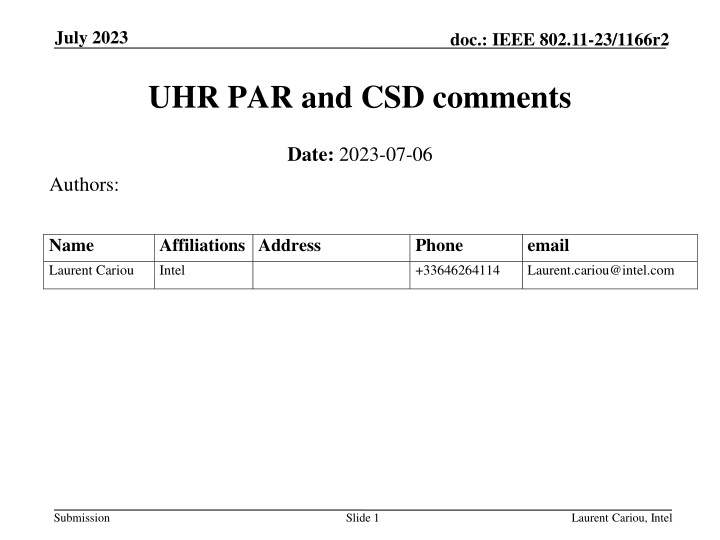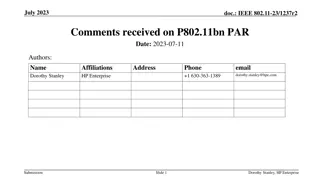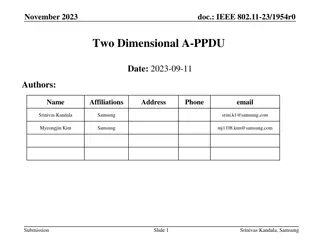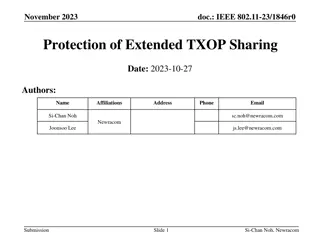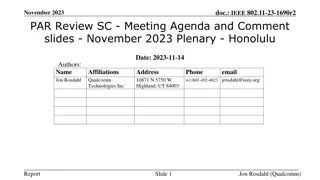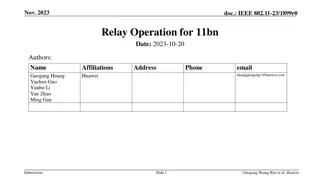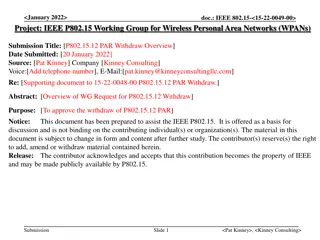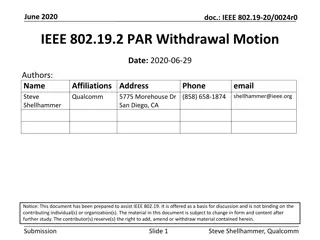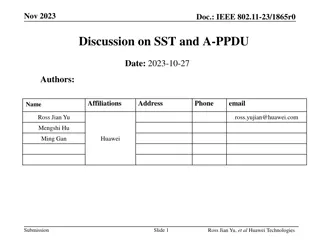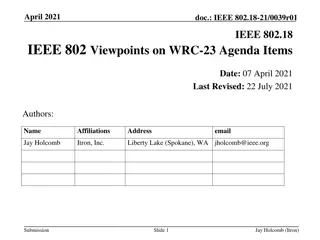IEEE 802.11-23 UHR PAR and CSD Comments Review
Reviewing comments and responses on IEEE 802.11-23/1166r2 UHR PAR and CSD focusing on enhancing Ultra High Reliability in Wireless Local Area Networks (WLAN) with clarifications and modifications for project scope and objectives.
Download Presentation

Please find below an Image/Link to download the presentation.
The content on the website is provided AS IS for your information and personal use only. It may not be sold, licensed, or shared on other websites without obtaining consent from the author.If you encounter any issues during the download, it is possible that the publisher has removed the file from their server.
You are allowed to download the files provided on this website for personal or commercial use, subject to the condition that they are used lawfully. All files are the property of their respective owners.
The content on the website is provided AS IS for your information and personal use only. It may not be sold, licensed, or shared on other websites without obtaining consent from the author.
E N D
Presentation Transcript
July 2023 doc.: IEEE 802.11-23/1166r2 UHR PAR and CSD comments Date: 2023-07-06 Authors: Name Laurent Cariou Affiliations Address Intel Phone +33646264114 email Laurent.cariou@intel.com Submission Slide 1 Laurent Cariou, Intel
July 2023 doc.: IEEE 802.11-23/1166r2 802.3 comments on 802.11 UHR PAR and CSD PAR 2.1 It isn t clear if the project is addressing hardware reliability or transmission reliability. These are very different things and this should be significantly more clear. Response: Thank you. Change is made to add this clarification in the section 8.1, which explains the name Ultra High Reliability. 5.2,b While the project scope may be technically accurate, it is very difficult to actually figure out what the goals of the project are. Please consider this in any rewrite. Response: Thank you. Section 5.2b is modified to clarify how we define the capability of Ultra High Reliability (throughput at range, latency, packet loss) and to provided quantified improvement for the constituent elements of this capability. Submission Slide 2 Some name (affiliation)
July 2023 doc.: IEEE 802.11-23/1166r2 802.3 comments on 802.11 UHR PAR and CSD PAR 5.2.b The project scope begins with an extremely difficult to parse run-on sentence. It would be helpful to know if these enhancements will apply to all 802.11 PHY types, or only selected PHY types (all PHY types is assumed in the following proposed revision of the project scope because of the listing of frequencies). Would the following better introduce the bulleted list: This amendment defines modifications to both IEEE Std 802.11 physical layers (PHYs) and the IEEE Std 802.11 Medium Access Control (MAC). The modifications will add Ultra High Reliability capability to Wireless Local Area Network (WLAN) Basic Service Sets (BSSs) or overlapping BSSs by providing: Response: Thank you. Make the change by following the suggestion from the commenter. Submission Slide 3 Some name (affiliation)
July 2023 doc.: IEEE 802.11-23/1166r2 802.3 comments on 802.11 UHR PAR and CSD PAR 5.2.b It isn t clear what the box after the list bullets was supposed to be (see posted PDF). Response: Typo. Change is made. 8.1, 2.1 explanation This is the only hyphenated usage of ultra high, be consistent. (It appears that Ultra High is chosen to agree with the previously used Extremely High (including capitalization within a sentence.) Response: Thank you. Change is made to remove the hyphen. 8.1, 5.5 explanation, 3rdparagraph Typo? (Basis Service Set) . Response: Thank you. Change is made to replace network by BSS. Submission Slide 4 Some name (affiliation)
July 2023 doc.: IEEE 802.11-23/1166r2 802.3 comments on 802.11 UHR PAR and CSD CSD 1.2.1 The answer is not responsive for this particular project. The Broad Market Potential response addresses wireless LAN in general, not the broad market for Ultra High Reliability. Response: UHR project is meant to be the next generation of mainstream WLAN. As such, the broad market of UHR is large. That said, the elements that are provided in the description are the ones that would benefit from the improvements that the 802.11bn project intends to provide. Changes are made to clarify this point. Submission Slide 5 Some name (affiliation)
July 2023 doc.: IEEE 802.11-23/1166r2 Comments on 802.11 UHR PAR and CSD: Paul Nikolich CSD In 1.2.4.b I suggest replacing "The increased capabilities envisioned for the baseband and RF parts necessary to implement the proposed amendment are in line with the current progress in technology and not expected to impinge testability." with "The increased capabilities envisioned for the MAC, baseband signal processing and RF technologies necessary to implement the proposed amendment are in line with the current progress of those technologies as demonstrated by lab testing, modeling and simulations." Response: Thanks. Accept Submission Slide 6 Laurent Cariou, Intel
July 2023 doc.: IEEE 802.11-23/1166r2 Comments on 802.11 UHR PAR and CSD: Paul Nikolich CSD There appears to be a cut-and-paste error in the 1.2.5.a and 1.2.5b of the CSD (see below). I suggest swapping the text under (a) and (b). 1.2.5.a) Known cost factors. WLAN equipment is accepted as having balanced costs. The development of Wireless capabilities to enhance the throughput and improve latency of WLAN network deployments will not disrupt the established balance. 1.2.5.b) Balanced costs. Support of the proposed standard will likely require a manufacturer to develop a modified radio, modem and firmware. This is similar in principle to the transition between IEEE 802.11ax and IEEE 802.11be as well as in previous iterations of IEEE Std. 802.11 enhancements. The cost factors for these transitions are well known and the data for this is well understood. Response: Thanks. Accept Submission Slide 7 Laurent Cariou, Intel
July 2023 doc.: IEEE 802.11-23/1166r2 Comments on 802.11 UHR PAR and CSD: James Gilb PAR 2.1 "Ultra High" violates the NesCom convention of not using comparative words rather than specific numbers. You need to specify somewhere what "Ultra High" means. (Also, it would be Ultra-High Reliability). How is reliability defined? No where do I find out what type of reliability is being sought. You need a different title for this that matches the description in the scope. I don't see any proposed additions that address reliability of any kind. Response: We understand that NesCom convention allows for an exception to this that must be explained. For this reason, we have provided in section 8.1 an explanation that is clarified following the comment. Changes are made also to clarify the definition of reliability as the 3 items described in section 5.2b, and to provide quantified target for these items. Submission Slide 8 Laurent Cariou, Intel
July 2023 doc.: IEEE 802.11-23/1166r2 Comments on 802.11 UHR PAR and CSD: James Gilb PAR 5.2b - The three items specified use "increasing", "improving" and "improving" with no numerical targets. This would imply that any tiny change would justify adding the new feature. Replace these with numerical targets, e.g., 50% more throughput. Response: Thank you. Changes are made in order to provide quantified values for the improvements. Submission Slide 9 Laurent Cariou, Intel
July 2023 doc.: IEEE 802.11-23/1166r2 Comments on 802.11 UHR PAR and CSD: James Gilb PAR 5.2b - If you are going to compare to EHT MAC/PHY, there needs to be a documented measurement for the baseline, or at least some sort of agreed upon method. This method needs to be referenced. Response: Make the change in section 8.1 to clarify that evaluation will likely be performed similarly to previous amendments. Submission Slide 10 Laurent Cariou, Intel
July 2023 doc.: IEEE 802.11-23/1166r2 Comments on 802.11 UHR PAR and CSD: James Gilb PAR 5.2b - How is "tail of the latency distribution and jitter" "improved"? What is the definition of "tail". At what value has the distribution fallen off enough for it to be the "tail"? Are you decreasing the integral of the tail? Response: Changes are made to clarify that what is improved is the latency, and the mention to tail is replaced by percentile of the latency distribution. Target values are also added. 5.2b - Efficient use of the medium does not uniquely define what is being sought. Is it bits/Hz? idle time? Specify the type of efficiency that is being improved and the numerical target. Response: This sentence is removed. Submission Slide 11 Laurent Cariou, Intel
July 2023 doc.: IEEE 802.11-23/1166r2 Comments on 802.11 UHR PAR and CSD: James Gilb PAR 5.2b - How is the power save "enhanced"? What is the characteristic that is being measured with respect to power save? In the need, battery life and lower energy bills are referenced, but the scope doesn't address either. Response: Change is made to focus the requirement on AP power save functionality which is a new functionality and no mention of enhanced is needed any more. Submission Slide 12 Laurent Cariou, Intel
July 2023 doc.: IEEE 802.11-23/1166r2 Comments on 802.11 UHR PAR and CSD: James Gilb PAR 5.5 - The need for the project states "align with a symmetrical broadband speed of 10 Gb/s", but nothing in the scope says that this performance target will be met. Is this a requirement for the amendment? If so, add it to the scope. If not, remove from Need. Response: Thanks. Remove from need. - Expand "P2P" on first use. Response: Thanks. First appearance in section 5.2b is expanded. Submission Slide 13 Laurent Cariou, Intel
July 2023 doc.: IEEE 802.11-23/1166r2 Comments on 802.11 UHR PAR and CSD: James Gilb PAR 8.1 (5.5) - "For example, a user experiencing marginal connectivity at the edge of a network today might experience improved connectivity with the defined enhancements." Will connectivity actually be improved with the changes? If so, how is connectivity measured and by what measure will it be improved? - "Conversely, an application (for example AR/VR) where the user experiences feedback lag under the current baseline might see reduced lag with the defined enhancements." The word "Conversely" doesn't belong here. Both can be true. Also, "might see reduced lag" isn't measureable. At some point the lag isn't noticeable. Is this a real problem and how will the proposed project address it? Response: Definition of reliability is clarified and the example of improvements are no longer needed. Response: Thanks. Change is made to replace with BSS. - "(Basis Service Set)" should just be ", BSS," (it is Basic, not Basis, anyway). Submission Slide 14 Laurent Cariou, Intel
July 2023 doc.: IEEE 802.11-23/1166r2 Comments on 802.11 UHR PAR and CSD: James Gilb CSD 1.2.4 a) - The text does not provide any information on demonstrated system feasibility. Which presentations show significant improvement in 802.11 performance? Response: Changes are made to clarify that there are presentations showing gains for some features to meet the PAR s objectives and clarify that the study group is confident on the technical feasibility of at least some of them. 1.2.4 b) The question does not have to do with testability. What testing, modeling or simulation shows that the improvements promised is possible? 1.2.5 a) The answer appears to be out of place. Balanced costs are item b). a) is known cost factors. I think you need to swap the answers. Response: Thanks. The answers are flipped. Submission Slide 15 Laurent Cariou, Intel
July 2023 doc.: IEEE 802.11-23/1166r2 Comments on 802.11 UHR PAR and CSD from 802.15 PAR 5.2.b fix suspect characters in the bullet list Response: Fixed 5.2.b The way 5.2b is written requires that all bullets must be achieved to complete the project is that correct? Response: yes 5.2b it is not clear how these items relate to Ultra-High Reliability . Please quantify Ultra- High Reliability and clarify the relationship between throughput, latency and efficiency and Ultra-High Reliability . Response: Changes are made to clarify how we define Ultra High Reliability capability in the context of the PAR, as 3 items, for which we now provide quantified improvement targets 5.3 - This standard appears to be dependent on 802.11be, which is not yet complete. Response: Only dependency is on evaluation of baseline performance. 802.11be features are now known and defined in a stable manner and can be evaluated. Submission Slide 16 Laurent Cariou, Intel
July 2023 doc.: IEEE 802.11-23/1166r2 Comments on 802.11 UHR PAR and CSD from 802.15 PAR 5.2.b We assume power saving should be a bullet; please describe how power saving is related to reliability? Response: Power save doesn t fall into the definition of reliability, but is an objective of the group. It therefore is captured as a separate point. Submission Slide 17 Laurent Cariou, Intel
July 2023 doc.: IEEE 802.11-23/1166r2 Comments on 802.11 UHR PAR and CSD from 802.15 CSD 1.2.3 states: There is no other WLAN standard focusing on improving WLAN throughput at different SINR levels in scenarios of an isolated BSS and overlapping BSSs, improving the tail of the latency distribution and jitter, enhancing mobility between BSSs, and providing mechanisms for enhanced power save for AP STAs (including mobile APs) other than this amendment. but the PAR states that the project is Enhancements for Ultra-High Reliability . Once again, the relationship between throughput, latency and efficiency and Ultra-High Reliability is not explained. Response: Changes are made in PAR and in CSD section 1.2.3 to clarify how we define Ultra High Reliability capability in the context of the PAR, as 3 items, for which we now provide quantified improvement targets 1.2.3 : There is no other WLAN standard focusing on improving WLAN throughput at different SINR levels in scenarios of an isolated BSS and overlapping BSSs Please confirm this statement is correct? Response: Confirmed Submission Slide 18 Laurent Cariou, Intel
July 2023 doc.: IEEE 802.11-23/1166r2 Comments on 802.11 UHR PAR and CSD from 802.1 PAR IEEE 802.1 appreciates the detailed review by IEEE 802.3 and James Gilb, and concurs with their comments on the PAR. In particular, if the title Ultra High Reliability is retained, IEEE 802.1 recommends that the scope be expanded to reflect the title. Notably the scope is lacking a clear description of ultra-high reliability. Alternatively, the title should be changed to reflect the contents of the current scope. Response: Thanks. Changes are made to clarify the definition of the Ultra High Reliability capability with 3 components (throughput, latency, MSDU/packet loss) and quantification is provided for the objectives of these components. Submission Slide 19 Laurent Cariou, Intel
July 2023 doc.: IEEE 802.11-23/1166r2 Comments on 802.11 UHR PAR and CSD from 802.1 CSD 1.2.1 a) Broad Market Potential Editorial: In the fifth paragraph, change The emerging of to The emergence of We suggest introducing Ultra High Reliability (UHR) at this point (fifth paragraph) in the text. In the seventh paragraph: Editorial: Change AR/VR headset to AR/VR headsets ( headset plural) Is M2M short for mobile to mobile ? Please spell out the acronym. Response: Thanks. Follow recommendation from comment. Some text are also removed following other comments. 1.2.1 b) Multiple vendors and numerous users This text focusses on WLAN only, with no mention of UHR. We suggest that, in the last line, continued progress of WLAN technology also include mention of UHR. Response: Thanks. Follow recommendation from comment. Submission Slide 20 Laurent Cariou, Intel
July 2023 doc.: IEEE 802.11-23/1166r2 Comments on 802.11 UHR PAR and CSD from 802.1 CSD 1.2.4 b) Proven similar technology via testing, modeling, simulation, etc. Editorial: Change several billions of to several billion . Response: Thanks. Change is made following recommendation from comment. 1.2.5 d) Consideration of operational costs (e.g., energy consumption). Editorial: Change a significant operation cost benefits to a significant operational cost benefit ( benefit singular) Response: Thanks. Change is made following recommendation from comment. Submission Slide 21 Laurent Cariou, Intel
